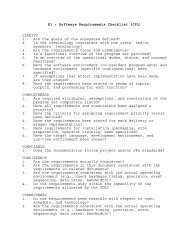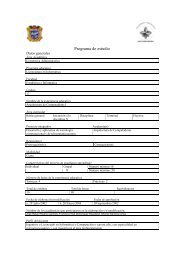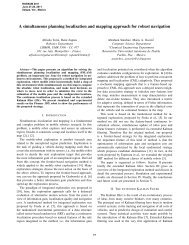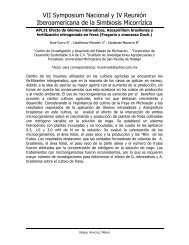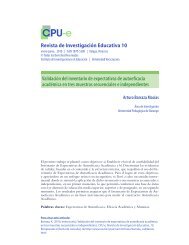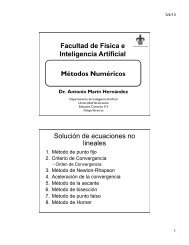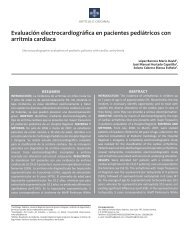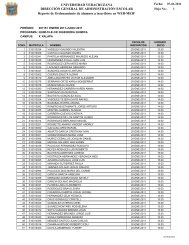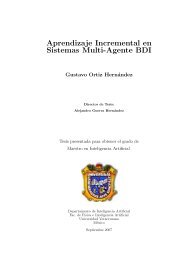Understanding the Software Options
Understanding the Software Options
Understanding the Software Options
Create successful ePaper yourself
Turn your PDF publications into a flip-book with our unique Google optimized e-Paper software.
TABLE 8. PURCHASE COST (C PCS) OF OTHER TYPES OF EQUIPMENT<br />
Centrifuges CapCost DFP CCEP<br />
EconExpert<br />
AspenPEA<br />
Dia., m<br />
Material<br />
CPCS ∆% ∆% ∆% ∆%<br />
CS3-Ct-101 2 CS 303,600 n/a +<br />
n/a +<br />
n/a +<br />
49%<br />
CS3-Ct-102 2 CS 303,600 n/a +<br />
n/a +<br />
n/a +<br />
Crystallizers<br />
49%<br />
CS3-Cr-101 21.9 CS 139,150 n/a +<br />
–76% n/a +<br />
Fired heater<br />
210%<br />
CS6-H-101 26,800 CS 1,078,700 63% 112% –46% 59%<br />
CS5-H-101<br />
Mills<br />
360,000 CS 6,405,500 –23% –15% –13% –35%<br />
CS7-C-101 0.00035 SS 67,100+ n/a +<br />
n/a +<br />
–90% n/a +<br />
Filtering centrifuges<br />
CS7-S-103 0.00002 SS 53,900+ n/a +<br />
n/a +<br />
181% n/a +<br />
Filters<br />
CS7-S-104 0.0075 SS 18,600* n/a +<br />
n/a +<br />
–99%* –98%<br />
CS7-S-101 1.5 SS 18,600* n/a +<br />
n/a +<br />
–89% –47%<br />
CS7-S-102 55 SS 131,000 n/a +<br />
n/a +<br />
n/a #<br />
–37%<br />
CS7-S-105 80 SS 170,200 n/a +<br />
n/a +<br />
n/a #<br />
31%<br />
CS7-S-106 90 SS 184,000 n/a +<br />
n/a +<br />
n/a #<br />
33%<br />
CS7-S-107 90 SS 184,000 n/a +<br />
n/a +<br />
n/a #<br />
33%<br />
Reactor-jacketed agitated<br />
CS3-R-101 28.4 CS 109,135 n/a +<br />
n/a +<br />
–70% n/a +<br />
CS3-R-102 28.4 CS 109,135 n/a +<br />
n/a +<br />
–70% n/a +<br />
* cost of minimum size as size is less than <strong>the</strong> minimum size<br />
+ not available in this program and so taken from ano<strong>the</strong>r program<br />
# purchase cost not available in EconExpert<br />
TABLE 9. TOTAL MODULE COST (C TM) OF<br />
EQUIPMENT<br />
Total module<br />
cost CapCost DFP CCEP<br />
Econ-<br />
Expert<br />
and agitated reactors are only available<br />
in CapCost and EconExpert. The<br />
results obtained from <strong>the</strong>se two are<br />
comparable (Table 8).<br />
Total purchase and module cost<br />
We also compared total purchase and<br />
total module costs for all pieces of<br />
equipment in each case study given<br />
by <strong>the</strong> different programs. For all programs,<br />
if a piece of equipment had a size<br />
above <strong>the</strong> valid range, it was divided<br />
into multiple units of smaller size and<br />
<strong>the</strong> costing was done by summing C TM<br />
for multiple smaller units. If a piece of<br />
equipment had a specification below<br />
<strong>the</strong> valid range, <strong>the</strong>n its cost was estimated<br />
by taking <strong>the</strong> lower limit of <strong>the</strong><br />
valid range. Similarly, if <strong>the</strong> flowrate<br />
was less than <strong>the</strong> minimum required<br />
for costing, <strong>the</strong> minimum flowrate was<br />
used (not actual). Since layers of silver<br />
wire gauze inside <strong>the</strong> reactor cannot be<br />
Aspen-<br />
PEA<br />
CTM ,<br />
Case study $million ∆% ∆% ∆% ∆%<br />
1 4.3 –6% –4% –36% –3%<br />
2 1.0 16% 71% –5% 68%<br />
3 2.5 6% –11% –14% 81%<br />
4 4.1 79% 19% –29% 28%<br />
5 33.3 27% –23% –28% –36%<br />
6 17.0 94% 14% 2% –11%<br />
7 9.4 34% 7% 8% 14%<br />
mapped to any equipment<br />
in <strong>the</strong> programs, it is not<br />
evaluated in case four. For<br />
similar reasons, <strong>the</strong> cost<br />
of catalyst pellets is also<br />
excluded in <strong>the</strong> total fixed<br />
capital cost in case five.<br />
The five programs give<br />
comparable purchase and<br />
total module costs for <strong>the</strong><br />
whole plant in each case<br />
study (Table 9 and online<br />
table VIII), with DFP giving<br />
a slightly higher cost<br />
in some cases. In case study two, both<br />
<strong>the</strong> purchase and total module costs<br />
obtained by ApenPEA are more than<br />
60% higher than those by CapCost.<br />
This is mainly due to <strong>the</strong> high costs<br />
of towers and vessels in AspenPEA.<br />
In case three, <strong>the</strong>re is good agreement<br />
among different programs except for<br />
AspenPEA, which shows higher purchase<br />
and total module costs due to<br />
<strong>the</strong> high costs of crystallizers and vessels.<br />
In case studies four and six, <strong>the</strong><br />
high deviations (more than 80%) in<br />
both purchase and total module cost<br />
in DFP are mainly due to cost differences<br />
in vessels and packing towers.<br />
Conclusions<br />
Although based on different methods<br />
and developed in different platforms,<br />
all five programs are user friendly<br />
and are useful tools for estimating<br />
<strong>the</strong> capital cost of chemical process<br />
plants. AspenPEA has <strong>the</strong> most equipment<br />
types available out of <strong>the</strong> five<br />
programs. DFP is <strong>the</strong> most limited in<br />
that regard. Based on our analysis,<br />
<strong>the</strong> overall plant cost does not deviate<br />
much among <strong>the</strong> different programs<br />
studied. However, equipment capital<br />
costs for different programs may not<br />
be comparable. There is generally<br />
good agreement for <strong>the</strong> purchase costs<br />
of floating-head heat exchangers.<br />
For fixed-head heat exchangers and<br />
pumps, <strong>the</strong>re is greater deviation in<br />
both purchase and total module costs<br />
among different programs studied.<br />
Also, <strong>the</strong>re is significant deviation for<br />
most vessels and towers in total module<br />
cost. Since material, pressure and<br />
installation factors vary in different<br />
methods in calculating total module<br />
cost, capital cost estimates may differ.<br />
Hence, while evaluating plant design<br />
alternatives, it is important to use<br />
only one program for cost evaluation<br />
of process design options to maintain<br />
consistent results. ■<br />
Edited by Scott Jenkins<br />
Editor’s note: Additional tables for total module<br />
cost of equipment are included in <strong>the</strong> online<br />
version of this article (www.che.com).<br />
Authors<br />
Ying Feng is currently a<br />
technologist at Shell Chemicals<br />
Seraya Pte. Ltd. She received<br />
a B.S.Ch.E. and a B.S.<br />
(economics) from <strong>the</strong> National<br />
University of Singapore in<br />
2010, with first-class honors<br />
in both degrees. She received<br />
a scholarship for her performance<br />
at <strong>the</strong> university, and<br />
also received a Baden-Württemberg<br />
Scholarship during<br />
her student exchange program at Karlsruhe<br />
Institute of Technology, in Germany. Feng’s research<br />
interests are capital cost estimation and<br />
optimization of petrochemical processes.<br />
G.P. Rangaiah has been with<br />
<strong>the</strong> National University of Singapore<br />
(21 Lower Kent Ridge<br />
Rd., Singapore 119077; Phone:<br />
+65 6516 2187; Email: chegpr@<br />
nus.edu.sg) since 1982, and is<br />
currently professor and deputy<br />
head for student and academic<br />
affairs in <strong>the</strong> Dept. of Chemical<br />
& Biomolecular Engineering.<br />
He received bachelor’s,<br />
master’s and doctoral degrees<br />
in chemical engineering, from Andhra University,<br />
IIT Kanpur and Monash University, respectively.<br />
Rangaiah worked at Engineers India Ltd. for two<br />
years before his doctoral study. His research interests<br />
are in control, modeling and optimization<br />
of chemical, petrochemical and related processes.<br />
Rangaiah has supervised ten research fellows<br />
and 35 graduate <strong>the</strong>ses. He has edited two books,<br />
published 120 papers in international journals<br />
and presented 100 papers in conferences. Rangaiah<br />
has received several teaching awards, including<br />
<strong>the</strong> Annual Teaching Excellence Awards from<br />
<strong>the</strong> National University of Singapore for four consecutive<br />
years.<br />
CHEMICAL ENGINEERING WWW.CHE.COM AUGUST 2011 29



